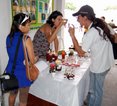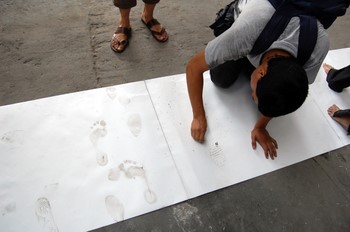Helena Productions,
Nov 18, 2008 - Nov 22, 2008
Cali, Colombia
7th Cali Performance Festival, Colombia
by Luisa Ungar
2. Hegemonic views
A critical approach to traditional forms of representation was a common theme in both the talks and the actions. These practices, which characteristically protest against hegemonic forms of representation, simultaneously face the issue of their own forms of reproduction. This kind of approach is particularly interesting in an art practice such as performance, which by definition does not lend itself to reproduction and has criticized the issue of documentation since its origins.(4) A performance is an event whose epistemology refers to action and focuses specifically on the "now". The horizon of particular meaning to which that "now" refers raises issues as to its reproduction that go beyond the formal aspect, and this gives rise to the question of traditional forms of representation. Performance art shares this trait with other performance-related practices outside the field.
Several of the talks focused on the issues stemming from this topic. In reference to the large-scale resistance movement that spread across the country last November,(5) Camilo López, the coordinator of the communication and culture program of the Fundécima Association -- which works with highland communities in Colombia -- showed a video of the cross-country march of native peoples, which had been in Cali two weeks earlier to seek a hearing with the president. The video focused on the army's assassination of four native Colombians, thus documenting an unrepeatable event. The reports I saw later in the mass media showed the march in a very different light. By that time the march as a narrative had gone beyond being represented in the traditional media and had spread by word of mouth in stories about the number of people marching, the failed meeting with Uribe, etc. Its existence held greater meaning than the ideological representations by the mass media.(6) In a conflict such as the one in Colombia, in which attempts to gain an ideological foothold and the struggle over territory are a constant, the relationship between an event and the way it is reported becomes highly significant given the ways the facts are manipulated to suit the interests of a hegemonic mass media.(7)
The issue of resistance to the way art is represented was addressed by Víctor Albarracín on behalf of El Bodegón.(8) In a talk on "non-profit harassment", Albarracín questioned the ideological position taken by "local" independent art platforms in regard to global capital, while referring to poverty as the social capital of art. This talk -- given in English with simultaneous interpretation -- offered a cash prize to curators and national and international promoters invited to the Festival.
The round-table debate that brought together other Latin American artists(9) brought to light different forms of resistance, with some participants confronting the institution's inability to adecuately represent them. Several engage in art practices in non-conventional spaces and all referred to their practice as a means of "giving people outside the field a little art": selling well-being (Omar Puebla) by carrying out their practice in cities, riding on buses as a means of selling their artwork (Al Zur-ich), distancing themselves from "museums and galleries that have closed their doors to them", distributing totemic animals or playing with the way national identity is represented (Juan Javier Salazar). Since they stem from relational practices, some of these talks encountered difficulties in seeking to reproduce the tactics used in their original contexts.
|











